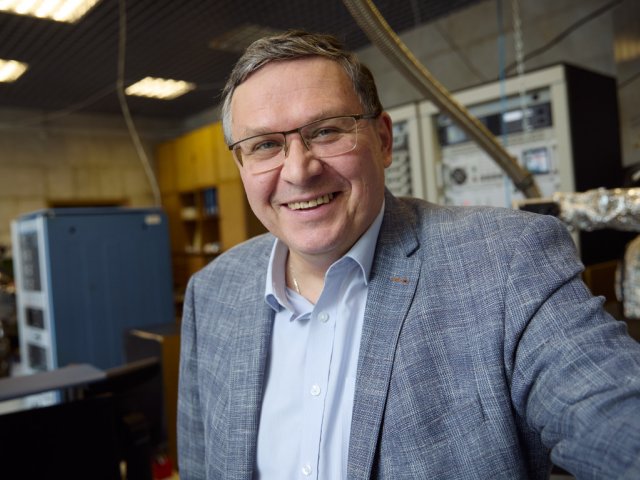In the autumn of 2021, the Russian Government approved a long-term strategy for low-carbon development until 2050. In February 2022, the discussion of the implementation plan for this program began.
Alexander Shirov, Director of the Institute of Economic Forecasting of the Russian Academy of Sciences, Corresponding Member of the Russian Academy of Sciences, talks about how the low-carbon development agenda can affect the economic situation in Russia in the coming years and the long term.
Alexander Shirov, Director of the Institute of Economic Forecasting of the Russian Academy of Sciences, Corresponding Member of the Russian Academy of Sciences
Photo: Andrey Luft / Scientific Russia
- The key position of the low-carbon development strategy is the transition to alternative energy sources. At the same time, Russia is one of the largest exporters of oil and gas. How does the global climate agenda affect now and will affect our export market of resources in the future?
- Russia is rich in natural resources, and, above all, hydrocarbons. Of course, the low-carbon development agenda affects the development of our economy, but we need to understand that this strategy and the change in the energy balance of both individual countries and the entire world is associated with a change in technology, which means it is quite a long process. It is no coincidence that the Russian low-carbon development strategy has a horizon until 2050. The question is how we will behave in the next 30 years in terms of economic and climate policy.
As for our hydrocarbons: they have been bought, are being bought, and will be bought. At the same time, it is clear that changes in the energy balance will lead to a change in the demand for certain types of our resources.
Coal is primarily under attack. We understand that many countries, primarily the European Union and China, are reducing the use of coal in their energy balances and replacing them with other energy sources, primarily renewable. Some experts raise the question of the consequences of a decline in income after our coal is no longer bought. However, according to our estimates, in the next 10-15, and maybe 20 years, the demand for our coal will remain, primarily from the countries of Southeast Asia, which in recent years have introduced a large amount of energy capacity on high-calorie coal.
As for oil, this is a question of switching cars with internal combustion engines to electric traction. Of course, this will reduce the demand for petroleum products, but at the same time, the demand for petrochemical products will grow in large volumes. For example, 3D printing requires the use of a large volume of petrochemical products for producing items with a wide range of purposes. We see a big demand for composite materials. There are more petrochemical products in the economy, and therefore the oil industry will also be in demand.
Well, and finally, gas. This is the least carbon-intensive resource among hydrocarbons, and demand for it in the next 30 years, most likely, will not decrease.
From the point of view of the demand for our goods in the world, the answer is simple: in the coming years the demand will remain, and the only question is how we use the resources we obtain from exports to modernize our economy. First of all, it is necessary to increase its efficiency to respond to the challenges that are associated, among other things, with the global climate agenda.
- That is, in the six years since the signing of the Paris Agreement, when talks about reducing the carbon footprint actively began, we have not noticed a decrease in demand for energy resources?
- Energy demand is a two-part story.
First, the economic growth. The economy is growing in both developed and developing countries. And if it grows, it requires more energy. The only question is the elasticity of the increase in energy demand relative to the GDP growth rate.
The second point is the replacement of some types of resources by others. But new technologies are expensive, and while the European Union can afford rapid decarbonization by aggressively increasing the share of renewable energy sources, many developing countries cannot afford this.
A fine example: over the past 10 years, about $3 trillion has been spent on the development of renewable energy sources. But looking at the structure of the global energy balance, we see that the share of renewable sources has grown very slightly, at the level of 2-3 percentage points. It takes a very long time and huge financial resources to get some kind of decisive result on a global scale, which most countries simply do not have. Hence, there is a certain conflict between the goals of increasing living standards and reducing greenhouse gas emissions.
Photo: Andrey Luft / Scientific Russia
- What prospects does Russia have in the field of alternative energy? What areas seem to be the most interesting for our economy?
- There are obvious forks in the global debate over low-carbon energy sources. For example, a significant part of the world community, for several reasons, does not consider nuclear and hydropower to be low-carbon. At the same time, another part, including Russia, believes that both nuclear power and hydropower are low-carbon because these energy generation methods do not emit CO2. In the European Union, although so far temporarily, nuclear energy is considered carbon-free. Gas is recognized as a source with a low level of greenhouse gas emissions. That is, first of all, the development of low-carbon energy is directed in this direction.
In general, if you look at the energy balance of Russia, you can see that our energy sector is very similar to the European one in terms of CO2 emissions, even though there is a huge share of renewable sources. For example, in the Netherlands and Germany. But the level of the carbon intensity of our economy is quite low precisely due to a sufficiently large share of nuclear and hydropower.
As for renewable sources: the problem, first of all, is that there is not sufficient production capacity for the production of equipment in Russia, and we do not have many key technologies in these types of energy. This means that with a sharp increase in the share of renewable energy sources, building new plants will be significantly more expensive than modernizing existing ones, for example, gas plants.
Of course, research work in the field of renewable energy should be carried out in Russia. We need these competencies in case it is still necessary to quickly increase the volume of capacity input from renewable sources. But so far, we see that the development of renewable sources is, primarily, about isolated energy systems. For example, near the BAM and the Trans-Siberian Railway – on the eastern polygon of the Russian Railway – this is effective. But if we now compare the specific cost of reducing greenhouse gas emissions during the construction of various electricity generation facilities, then, all other things being equal, the modernization of a gas power plant is currently ten times cheaper than the construction of a wind or solar plant.
In fact, the problem of high greenhouse gas emissions in our energy sector lies not in the energy itself, but in the insufficient efficiency of other sectors of the economy that consume energy, primarily housing and communal services. We understand that most Russian residential buildings have extremely low energy efficiency. Houses were built at a time when, in general, no one thought about energy efficiency: in the Soviet economy, energy was very cheap for the consumer. Accordingly, to change this situation, enormous resources are required: new heating networks, modernization and repair of apartment buildings, construction of new housing in place of the old one. But this must be done, otherwise it is impossible to solve the problem of decarbonization and increase the efficiency of our economy. Housing is just one example, there are similar problems in many sectors of Russian industry.
- It is clear that no one will give up oil, gas, and coal in the near future. But in the long term, given the difference in the level of technologies for creating renewable sources, could Russia turn from an energy exporter into an importer?
- This is an unrealistic scenario. Our energy generation structure assumes both an increase in the share of nuclear and hydropower, and a significant increase in the share of renewable sources. According to the calculations that are the basis of the low-carbon development strategy, by 2050 the share of renewable sources in Russia will be 14%, and the share of nuclear energy will increase to 25%. Coal will account for about 5% of the total energy generation in our country. At the same time, it should be borne in mind that this 5% are rather redundant capacities that are needed to maintain the balance of the power system, its security.
- When the low-carbon development strategy was discussed, several scenarios were published: basic, reasonable, aggressive, and targeted. What is their difference, and which path looks real now?
- The main differences between these four scenarios are in the set of economic policy measures for decarbonization. The idea is that we are still lagging behind most developed countries in terms of the level of technologies used. On the one hand, this is bad, and we want this situation to change. But on the other hand, the range of solutions that we have at our disposal is almost limitless. When choosing technologies that will be used to reduce greenhouse gas emissions, designing a set of them, we roughly understand how much it will cost. That is, what percentage of GDP we will spend on investments in decarbonization.
The intensive scenario that was once considered implied an additional 3% of GDP for decarbonization purposes. On the one hand, it is good: investment means GDP growth and additional economic growth. But these three percent mean that we use expensive technologies. And it is these expensive technologies that sooner or later, or rather sooner, will begin to be translated into the price level of energy and energy-related goods. This will lead to the fact that the pace of economic growth with such high investments may be slower than we would like. These three percent of additional investments in decarbonization provided approximately minus 0.6 percent of the average annual GDP growth rate for the period up to 2050. You need to understand what six-tenths of a percentage point every year is: in total, it’s trillions, if not tens of trillions of rubles. And our economy is losing these tens of trillions of rubles, that is, the scenario of aggressive decarbonization negatively affects economic dynamics, does not allow us to achieve the economic goals that we set for ourselves. That is, we see the already mentioned conflict between the goals of economic development and decarbonization.
Hence, it became necessary to form other scenarios that, on the one hand, would allow our economy to have GDP growth rates, and on the other hand, would allow us to declare that Russia will be able to ensure carbon neutrality in the foreseeable future.
Now there are two development scenarios: target and base. This is precisely the result of a compromise within the framework of calculations and the formation of a set of actions to reduce emissions. The target scenario, on the one hand, provides an average annual economic growth rate of around 3%, and on the other hand, the additional investments provided for decarbonization, about 1.8% of GDP, do not have a significant negative impact on prices and domestic demand. Thus, we do not restrain the level of income of the population, we do not put excessive pressure on our business, but through decarbonization, we increase the efficiency of the economy, that is, we give an additional impetus to sustainable economic growth.
And the base scenario is needed to show that if nothing changes, we will not achieve our economic growth goals, and we will not fulfill our obligations to reduce greenhouse gas emissions. That is, it is simply unacceptable to develop according to the base scenario.
- So, in fact, we are left with one development scenario?
- Yes, but the main problem is that the low-carbon development strategy is the first document of such a long period, that is, until 2050. It is clear that in addition to the problems of decarbonization and its connection with economic growth, a lot of other documents in the field of strategic economic development are required.
First of all, a general strategy for the socio-economic development of our country, which should describe the whole plot: decarbonization, technological development, demography, and several other factors that affect the development of the economy in the long term. This is exactly the kind of work going on in the government.
Photo: Andrey Luft / Scientific Russia
- How do the low-carbon development strategy and its economic aspects reflect the absorption capacity of Russian ecosystems?
- When you plunge into the climate agenda, at a certain moment you make a big discovery for yourself: it turns out that not everything depends on the economy.
We talk all the time about the anthropogenic impact on the climate, but no less important element is the impact of the ecosystem on greenhouse gas emissions: forests, soils, rivers, oceans, swamps. And this is very important. Starting to get acquainted with this, you realize that we do not know very well the country we live in, its ecosystems, and their interaction with the environment. And how all this affects the climate.
In the 1990s and 2000s, too little money was spent on the study of these tasks, but now when we begin to look at these issues in the complex of the entire low-carbon development strategy, we understand that the contribution of this factor is enormous and how important research in this area of knowledge is.
In fact, the reduction of greenhouse gas emissions in the target scenario by about 40% is provided by technology and economics, and by almost 60% by our ecosystems. This is a big challenge that is being formed in front of Russian science. It is the science that should ensure the verification of understanding on the global platform of how serious the absorption capacity of our ecosystems is. This is a question not only for experts in the field of ecosystems or climatologists – it is a question for the entire scientific community.
The efforts of mathematicians are required because climate modeling is very serious. These are chemistry, physics, climate, soils, forests, and oceans – a whole group of specialties. Perhaps it is difficult to imagine a specialty that cannot be used in this case – this is the largest scientific project that integrates all the scientific space that we have, so I compare it with atomic and space projects.
Now the question is how to build this work. There are different tools, and they are being considered by the government. First of all, this is the Federal Scientific and Technical Program on Climate: these are projects that were considered, among other things, at the Presidential Council for Science and Education on February 8. Work is underway, certain centers are being formed, and the scientific community, universities, and academic institutions must be actively involved in this.
- Do we have to prove to the world scientific community the effectiveness of our ecosystems?
- The advantage of this scientific project, first of all, is that collaboration is required. We should not just understand this for ourselves, or report to the president and the government, but prove it on international platforms, show it, and get approval for the research that will be done in various areas of the climate agenda.
- How does the world community view these issues?
- The world community has different views. I gave the example of nuclear energy: here we have natural allies like France, the UK, the US – those who possess nuclear weapons. For these countries, including Russia, the civil sector is an integral element of the entire nuclear complex. There are other scenarios. For example, the fact that gas is recognized as a less carbon-intensive fuel is very beneficial for Germany, which rejects the atom but must somehow reserve the energy system.
We also have natural allies on forest issues: countries with a lot of forests, for example, Finland and Brazil. In this area, we can speak the same language as them. This also applies to other areas of the climate agenda.
The challenge is to ensure that scientific diplomacy within the framework of discussing climate problems be no less lively than what happens at the government level when they discuss, for example, cross-border carbon regulation – that is, tax restrictions in this area.
- The COVID-19 pandemic has hit the entire global economy, this is clear. But how has it affected the low-carbon strategy, both Russian and global?
- The complexity of economics is that it is practically impossible to experiment in it, for example, as in physics or chemistry. Like other social sciences, economics studies processes in which the behavior of agents (population, state, business) is important, therefore modeling and calculations, even the most complex, cannot be the ultimate truth. But when such an experiment arises as a result of some kind of shock, such as the COVID-19 pandemic, then, of course, all the attention of analysts is focused on it.
What have we noticed during the pandemic? We have seen that due to lockdowns, greenhouse gas emissions in cities have sharply decreased. This applies to China, Europe, and Russia. At the same time, the reduction in emissions led to the fact that the atmosphere became more transparent, and this also affected the warming parameters. The situation was monitored by climatologists and other specialists in this field. The problem is that such a short period does not have a serious impact on the climate, which means it is quite difficult to draw generalizing conclusions.
But we have felt how much it is necessary to reduce the level of economic activity to achieve lower greenhouse gas emissions. The lockdowns showed that to abruptly switch to carbon neutrality now, for example, in China, the Chinese economy must, in fact, stop. And this once again confirms that now the climate agenda in one way or another contradicts the Sustainable Development Goals. I would like them to be resolved through a conscious compromise, not coercion.
Photo: Andrey Luft / Scientific Russia
- A plan for implementing Russia’s low-carbon development strategy is currently being discussed. What are the key points of this plan?
- The fact is that there are very few figures in the low-carbon development strategy. Of course, this strategy is based on complex climate and economic calculations, but there are relatively few figures in it.
Therefore, the plan should turn the strategy into a set of sectoral, and then, possibly, regional actions that will ensure its implementation. This means that the requirements are imposed not so much on ministries and departments, but rather on specific companies and business associations that must form their own vision of achieving the goals set by the strategy. Thus, this development plan can be implemented taking into account the contribution of individual sectors of the economy. This is probably the main thing.
- The strategy of low-carbon development can hit businesses first. Is there any incentive in the plan for Russian companies to reduce greenhouse gas emissions?
- The main compromise of the strategy is between the medium-term perspective of economic development and decarbonization. An active reduction of emissions is possible only after resources are concentrated and certain investment projects in certain sectors of the economy are completed.
On the one hand, it is necessary to stimulate investments in decarbonization. On the other hand, there is an understanding that the basic level of investment in fixed assets, how quickly production is updated, will contribute most to reducing greenhouse gas emissions.
Imagine any businessman who expands or modernizes production: they buy more modern equipment, which by definition is less energy-intensive and generates less emissions. It turns out that this is a natural process that depends on the overall dynamism in the economy, the speed of its modernization.
A lot depends on the overall investment climate in the country: on the pace of economic growth and on how the business perceives the prospects for the development of the economy as a whole. Not everything depends on the decarbonization policy: much is influenced, for example, by the level of interest rates, the ruble exchange rate, and other factors that we call economic policy.
Speaking about specific incentives aimed at decarbonization: there is now a consensus that most of these incentives should be voluntary, that is, not formed through coercive mechanisms.
If a business tries to reduce the carbon load, behaves responsibly in this area, such behavior should be rewarded. But with irresponsible behavior, restrictive measures aimed at deterring such businesses can already be taken.
I would call the strategy of low-carbon development a compromise: between the goals of economic growth, reducing emissions, the obligations that the state has assumed at the global level, and the stance of the business community.
- Clearly, the transition to zero carbon footprint is expensive. But can it become profitable in the end, or will it be costly at any stage?
- Costs are not always a bad thing; investments are a direct plus to gross domestic product. The only question is how to return these investments.
The target development scenario, which is now considered as the main one, provides us with growth rates above three percent on average per year, until 2050. This is a very high rate: every year, for 30 years, the economy will grow by more than 3%.
In addition, the target scenario ensures the modernization of the economy, because reducing emissions is, first of all, modernization. These are new technologies, the transition of metallurgy to electric smelting, a large share of electric transport, modernization of energy and housing, and communal services – all that we really need anyway.
At the same time, the volume of investments does not reduce the pace of economic growth, and the cost of the package allows us to solve the tasks that we set ourselves in the medium and long term.
- The global climate agenda and low-carbon development strategy are compared with the industrial revolution of the 19th century. Do you agree with this?
- There is also a good term ‘energy transition’ – when you start using another energy raw material instead of one. All energy transitions, including technological revolutions that have been so far, are associated with the replacement of less efficient with more efficient resources.
Now is a fundamentally different situation. If you look at the specific parameters of economic efficiency and traditional energy sources, it is clear that renewable ones are less efficient and require additional investments in capacity redundancy. One day, perhaps, the cost of the kilowatt produced will drop completely, but at the moment we are moving to a less efficient type of fuel. Clearly, there is a price to pay.






























